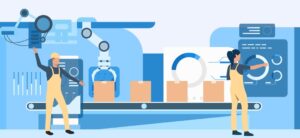Data is every enterprise’s most valuable asset, but for most organizations, it’s also their biggest burden. Legacy databases, inconsistent formats, and siloed systems have made modernization a never-ending project. You can migrate to the cloud, centralize data lakes, or upgrade warehouses yet, the real bottleneck often remains: turning raw data into reliable, actionable insight.
That’s where Generative AI is redefining what modernization means. Beyond content creation, generative models can auto-suggest data models, generate synthetic datasets, and even automate data quality improvement turning yesterday’s static systems into dynamic, self-improving ecosystems.
In this article, we’ll unpack how Generative AI is reshaping the Data Modernization Strategy for forward-looking enterprises and how your organization can start adopting this intelligence layer for faster, smarter outcomes.
Looking to evolve your data ecosystem with AI? Connect with our AI experts to explore what’s possible.
Why Data Modernization Still Feels Broken
Despite years of investment, most modernization programs still underdeliver. Why? Because the process is often treated as a migration exercise, not a transformation opportunity.
Common Challenges:
- Siloed legacy systems: Data silos prevent holistic insight and collaboration.
- Poor data quality: On-prem bottlenecks slow analytics and AI deployment.
- Slow transformation cycles: Manual data cleansing, mapping, and governance workflows consume months.
- Limited ROI visibility: Once migrated, data often remains underutilized.
According to Gartner over 60% of enterprises report that their data modernization efforts fall short of delivering business agility. The core issue? Traditional modernization stops at infrastructure; it doesn’t make the data smarter.
Takeaway: Modernization today isn’t about where your data lives; it’s about how intelligently it behaves.
Enter Generative AI – The Intelligence Layer for Modernization
Generative AI brings a new dimension to data management; it doesn’t just process data, it understands and evolves it.
Unlike predictive AI, which forecasts outcomes, Generative AI can create and improve data structures themselves. When applied to modernization, it becomes a co-pilot for data engineers, reducing manual effort while enhancing accuracy and consistency.
Here’s how it transforms key phases:
- Data Modeling: Auto-suggests optimal schema designs based on historical usage.
- Data Cleansing: Detects anomalies and fills missing data using synthetic generation.
- Metadata Enrichment: Uses NLP to automatically tag, classify, and catalog assets.
- Migration: Generates code, queries, or transformation logic dynamically.
- Governance: Suggests access policies and compliance configurations.
Example: During a cloud migration, a generative model analyzes legacy database schemas and auto-suggests harmonized table structures, eliminating weeks of manual mapping work.
Our Generative AI development services integrate these capabilities directly into your modernization pipelines, enabling faster, error-free transitions.
Core Pillars of an AI-Driven Data Modernization Strategy
To truly leverage AI’s potential, enterprises must evolve from isolated automation to an AI-augmented modernization framework. Below are the five foundational pillars that define a next-generation approach.
Automated Data Discovery & Cataloging
Traditional metadata documentation is slow, manual, and often outdated by the time it’s complete. Generative AI changes this by:
- Automatically parsing and understanding datasets using NLP and embeddings.
- Suggesting standardized metadata tags and lineage information.
- Continuously updating the data catalog as sources evolve.
Result: Data teams spend less time on discovery and more time on innovation.
AI-Enhanced Data Quality & Cleansing
Poor data quality is the silent killer of analytics ROI. Generative AI models can:
- Identify missing, duplicate, or corrupted data.
- Generate synthetic records that maintain statistical integrity.
- Suggest transformation logic to improve uniformity and reliability.
Example: A financial institution used a generative AI system to fill missing credit history fields using modeled patterns from similar customer segments improving model training accuracy by 35%.
AI-Driven Data Transformation & Migration Automation
Generative AI is redefining ETL (Extract, Transform, Load).
- It can generate SQL scripts or Python code automatically for common transformations.
- Detect transformation conflicts and suggest resolutions.
- Validate data post-migration to ensure parity between systems.
Governance, Security, and Compliance Through AI
Modernization is incomplete without governance. Generative AI helps by:
- Auto-suggesting access control policies based on role behavior.
- Generating data lineage graphs for audit and compliance reports.
- Simulating compliance scenarios (e.g., GDPR, HIPAA) to flag potential violations before deployment.
These capabilities make compliance proactive rather than reactive.
Continuous Modernization Loop
The biggest breakthrough: data systems no longer need to be manually modernized every few years. Generative AI enables continuous modernization where the system learns from usage, identifies outdated structures, and recommends improvements autonomously.
We call this the A.I.M. Framework – Automate, Integrate, Modernize.
A.I.M. Framework Summary:
| Stage | What Happens | AI’s Role |
|---|---|---|
| Automate | Routine data discovery & cleaning | Auto-suggest transformations |
| Integrate | Merge across silos & formats | Generate connectors, resolve conflicts |
| Modernize | Continuously optimize data flows | Suggest schema & governance updates |
Real-World Applications of Generative AI in Data Modernization
Generative AI’s versatility means it’s not confined to a single industry or function. Here are real-world applications across verticals:
Banking & Financial Services
- Use Case: Unifying customer KYC data across systems.
- How AI helps: Auto-suggests consistent data models and merges duplicates, creating a 360° customer view.
- Impact: Reduces onboarding time by 30% and compliance overhead by 25%.
Healthcare & Life Sciences
- Use Case: Training AI models without exposing PHI (protected health information).
- How AI helps: Generates synthetic datasets mimicking real-world patterns, enabling secure AI development.
Retail & E-Commerce
- Use Case: Harmonizing product and pricing data across multiple regions.
- How AI helps: Auto-generates unified schema and transformation logic, keeping catalog data clean and consistent.
Enterprise Data Management
- Use Case: Accelerating master data management (MDM).
- How AI helps: Suggests hierarchies, enriches metadata, and identifies missing relationships automatically.
Checklist — Building Your Generative AI-Enabled Data Modernization Strategy
Here’s a quick-action checklist to help you start implementing AI-driven modernization:
- Assess current data maturity — map your architecture, tools, and gaps.
- Prioritize modernization goals — cost reduction, quality improvement, or faster analytics.
- Integrate AI for metadata discovery — deploy models for automated cataloging.
- Pilot Generative AI for cleansing — start small with a critical dataset.
- Automate migration scripts — use LLMs to generate and validate ETL code.
- Embed AI in governance workflows — enable auto-policy and lineage mapping.
- Measure time-to-insight gains — track before-and-after efficiency metrics.
Partnering for Generative AI Development Services
While internal teams understand their data best, scaling Generative AI across the ecosystem requires deep expertise in both AI engineering and data architecture. That’s where Generative AI development services make a measurable difference.
Why partner with experts like Intellectyx?
- End-to-end modernization strategy from data discovery to deployment.
- AI model development tailored to your architecture.
- Integration with existing cloud, warehouse, or analytics platforms.
- Accelerated ROI and compliance readiness.
Intellectyx helps enterprises embed Generative AI into their modernization roadmap turning data from a cost center into a competitive differentiator.
Book a free consultation with our AI experts to explore your readiness
The Future: Toward Autonomous Data Ecosystems
The next evolution of data modernization isn’t migration, it’s autonomy. In the near future, enterprises will deploy AI agents that continuously monitor, correct, and evolve data pipelines. Imagine a system that:
- Identifies schema drift instantly.
- Suggests updates to improve query performance.
- Regenerates datasets as regulations or business needs change
That’s not a distant vision, it’s already taking shape in AI-first enterprises.
Final Thought:
Data modernization powered by Generative AI is not a one-time project; it’s a living, evolving system that learns, adapts, and improves. The winners in this new era will be those who treat intelligence as infrastructure.




